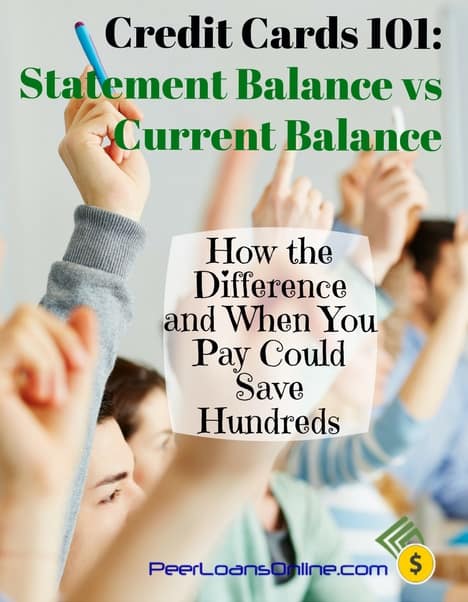Knowing the difference between statement balance and current balance is one of the most important ways to save on credit cards
Credit cards can be your best financial tools or they can be weapons of financial destruction.
Understanding how to use your credit cards will mean the difference between saving thousands of dollars or paying that much in fees, interest and late charges.
Of course, the credit card companies don’t always make it easy. They have a vested interest in getting you to pay as much as possible for your card. It may seemingly be a worthless piece of plastic but to the card companies, it’s a trillion-dollar industry.
One of the ways credit cards trick people is by the glossary of terms to confuse you and cause you to pay more than you should.
One of the most confusing is the difference between statement balance versus current balance.
I’m going to show you why that difference matters, how much you should pay on your credit card statement and how it will save you hundreds.
How Do I Avoid Paying Interest on a Credit Card?
Your credit card issuer will send you a statement every month. Most give you a 21-day grace period to pay your bill before they start charging interest.
That interest will be charged on your statement balance, not the current balance. The company will take your average daily balance and multiply it by the monthly interest rate to calculate the interest charge.
If you pay your statement balance before the grace period, you won’t owe any interest on the card. It’s like a short-term, interest-free loan.
Why You Should Only Pay the Statement Balance vs Current Balance
Where a lot of people get confused is logging in to their credit card account and immediately seeing the current balance. Even when you go to make a payment, you’ll often see your current balance right next to the statement balance in payment options.
Your current balance is everything you owe on the credit card that hasn’t been paid. That includes the amount in your statement balance from the last month plus any purchases you’ve made since your last statement.
The credit card company would love for you to pay your current balance. That means they collected the processing fee from the seller when you made the purchase but they don’t have to sit on that loan for a month when you pay your next statement.
You might think it doesn’t make much difference whether you only pay the statement balance or the current balance but it can save you hundreds.
If you’re paying your full account balance rather than just the statement balance, that means you’re not using that money to pay off other loans. That means you’re paying interest on those other loans when you could be paying them off with an interest-free loan from the credit card company.
For example, let’s say your current balance is typically $1,500 more than your statement balance. If you have other loans at a 15% annual rate, that $1,500 a month will cost you over $200 a year in interest.
The difference between your current balance and statement balance is interest-free until your next statement so take advantage of it.
When Should You Pay Your Credit Card Statement Balance?
You don’t pay any interest on your statement balance until the end of your grace period. That’s usually your statement due date. You’ll usually get your statement at least two weeks before the due date.

I’m not smart.
I always pay my credit card statement as soon as I get the email. I know I could wait but if I have money in my checking account to pay the bill, I usually just take care of it immediately.
Most credit cards will give you the option of scheduling a payment. I’m not a big fan of this because what happens if you schedule a payment and then have other bills paid in that time. If you’re not watching your account balance, you could be on the hook for big overdraft fees.
Waiting to make your credit card payment just before the due date will save you money, using cash to pay other loans, but make sure you’re able to get the payment made in time.
Why is My Current Balance Lower than Statement Balance?
If you’ve gotten any refunds since your statement balance, your current balance will be lower. Your credit card company may have also applied any cash back money to your account.
It’s rare that your current balance will be lower than the statement balance but it does happen. More often, your current balance will be higher if you’ve made any purchases since the statement close date.
Understanding the different credit card terms, especially the difference between the statement balance and current balance, could save you a lot of money. Credit cards are a financial tool and like any tool, knowing how to use it will help you get the most out of it.
So in your opinion, it’s better to pay the statement balance or pay both the current and the statement balance. in a simple reply.
Thank you.
Definitely pay the statement balance. If you can pay the current balance, that will make it easier to pay the rest off at the end of the next month.